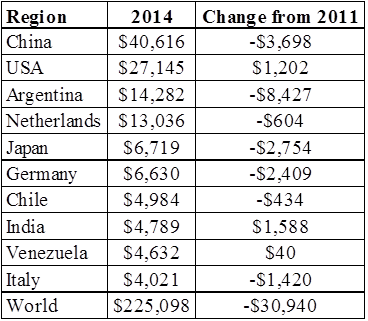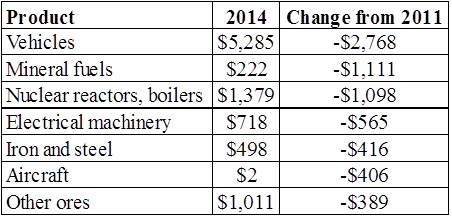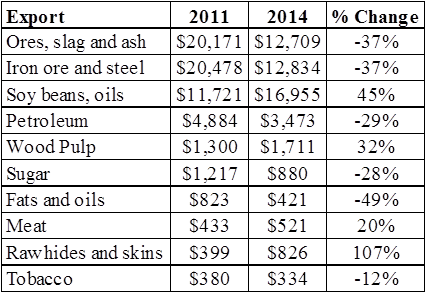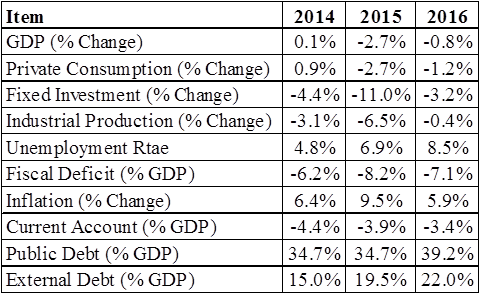Introduction
In late 2008, I wrote a series of articles with my students at the University of Palermo’s Business School in Buenos Aires. The articles examined the economic impact of the global depression started in 2008 on a selection of Latin American countries. On Brazil, my co-authors (Roberto Flamini and Paula Gomez) and I concluded:
“The 2008 global collapse had little impact in Brazil. In fact, its effects in Brazil were far less than previous global downturns. Overall, Brazil has become one of the soundest economic powers in the world. With diverse exports, a growing middle class, and a broad natural resource base, Brazil’s prospects are excellent”.
And yet, Brazil now appears to be in horrible shape: the country is in recession with GDP projected to fall 2.7% this year. Business and consumer confidence are at record lows with investment and consumption expenditures declining. The government deficit has shot up and is now projected in the FocusEconomics’ “LatinFocus Consensus Forecast” to reach 8.2% of GDP in 2015. And this, after a GDP growth rate of 7.6% in 2010. What happened?
Pundits point to the need to diversify exports and reduce corruption. In what follows, these and other factors contributing to the downturn are considered. But first, Brazil is placed in its Latin American setting.
Brazil in Latin America
Brazil is the largest of the Latam countries, measured by both population and GDP. It is only one of two countries with a declining GDP, the other being Venezuela. Its GDP per capita ranking is about in the middle. A Gini Coefficient is a measure of income inequality with a 0 meaning equal incomes and a 1 meaning complete inequality. Income inequality in Latam is high relative to the rest of the world and particularly so in Colombia, Brazil, and Chile.
Table 1. – Basic Economic Statistics, Latam Countries

Source: FocusEconomics, Inter-American Development Bank
Exports
Some argue Brazil’s problems could be solved through greater export diversity. Sure, this is an easy thing to suggest in light of what happened to commodity prices in the last few years. But this is a misconception: Brazil is not suffering from a lack of diversity in its exports. I quote from a World Bank policy paper on the subject:
“Brazil is recognized as a global trader, endowed with a wide range of natural resources along with a well diversified industrial structure. This translates into an impressive level of export diversification, not only in terms of number of destinations, but also of products. When compared with other countries the Brazilian economy proves to be able to sell a large number of products in many markets.”
One measure of export diversity is the percentage share of the top 15 export products: the higher this number is, the less is the diversity. Table 2 provides these data for Latam countries. Brazil is second only to Mexico in having diverse exports. And
Table 2. – Latam Countries, 15 Leading Export Products’ Share

Source: Inter-American Development Bank
But Brazil did have a 12.5% export decline between 2012 and 2014, and another 12% fall is expected in 2015. So what is happening? Table 3 shows export change by country since 2011.
Table 3. Brazil: Export Change 2011 – 2014 by Country (mil. US$)

Source: UN Comtrade
It is interesting that the largest export decline was to Argentina and not China (its largest export partner). Details on the Argentine export decline are provided in Table 4. Many of these reductions stem from the weakening Argentine economy.
Table 4. – Change in Leading Exports to Argentina (mil. US$)

Source: UN Comtrade
Exports to China tell a quite different story (Table 5). Unlike the Argentine case where a good deal of the declines came in manufactured products, most of the China cutbacks came in commodities.
Table 5. – Change in Leading Exports to China (mil. US$)

Source: UN Comtrade
So why the large reduction in commodity exports to China? The export declines can hardly be attributed to a decline in the Chinese growth rate. After all China’s GDP still grew at a hefty 7.3% in 2014. Rather, the answer lies in what happened to commodity prices. As Table 6 indicates, there were huge price declines in most of Brazil’s export commodities.
Table 6. – Changes in Commodity Prices, 2011 – 2015

Source: indexmundi.com
How Important Is the Export Decline?
In 2015, total GDP is projected to be down $865 billion (33%) since 2011. The export decline is projected at $61 billion, and its multiplier effects will increase its overall GDP impact considerably.
As mentioned earlier, some say Brazil is too dependent on commodity exports. It is far too soon to draw this conclusion. Brazil is resource rich. Should it not take advantage of this comparative advantage? Commodity prices fluctuate and most will recover.
Others say Brazil is too dependent on China for exports. That is like saying Brazil should not sell its products in the global market to the highest bidder. China and India offer the largest and most rapidly growing markets for Brazil to develop.
Corruption
Some claim corruption is the number one challenge facing Brazil. I don’t see it. There are two types of government corruption. In the most serious type, corruption blocks needed government reforms. For example, groups favoring the status quo in India have blocked energy reforms. And in the US, as a result of the lobbying and campaign contributions of hospitals, doctors, and insurance companies, US health care is the most expensive and least effective of any developed country.
The corruption problem in Brazil is not of this type. In Brazil, a small share of Petrobras' (N:PBR) profits was siphoned off. That meant the company’s profits were a bit lower than they should have been, but there is no evidence that the operating policies of Petrobras were affected. There is also plenty of this type of corruption in China: illegal monies end up in the hands of government officials. But the corruption rarely influences the government’s policies.
Changes in Exchange Rates and Inflation
Several years back, the Brazilian Central Bank was complaining that the real (the Brazilian currency) was too strong relative to the dollar, thereby putting its exporters at a disadvantage. This has all changed. Today, the Brazilian exporter gets R$3.87 for every USD of exports versus only R$1.86 in 2011. On the other hand, the weaker real means imports have become far more expensive to Brazilians. And higher import prices have contributed to inflation (34% since 2011).
Investments
It is an understatement to say that since 2011, the Brazilian stock exchange has not performed well: the stock market (Bovespa) is down 33% since 2011. In 2011, the stock market capitalization was $1.2 trillion; today, it is $514 billion. Needless to say, this huge loss in wealth is having a negative impact on the consumption outlays of Brazilians.
Table 7. – Change in Brazil Stock Market and ETFs, 2011 – 2014

Source: Yahoo Finance
Conclusions
Brazil is going through tough economic times. Table 8 provides the FocusEconomics consensus forecasts of more than 15 financial organizations. GDP, consumption, investment and industrial production are declining sharply (and who really knows about 2016). The unemployment rate is increasing, as is the government debt and inflation. The good news is that Brazil’s debts are quite low by international standards.
Table 8. – Brazil: Economic Data
Source: FocusEconomics
Things will not get much better in Brazil for a few of years. Commodity prices will not turn around overnight, nor will the recession now underway in Brazil. Its political problems will continue. And sluggish productivity performance, in part the result of powerful unions, is a drag on its competitiveness.
But things will get better in Brazil. Its exports will recover and its large and growing middle class will spur the recovery. It is a diverse, natural resource-rich country with a strong private sector. In fact, taking a five year horizon, Brazil is at the top of my list of emerging market countries.

